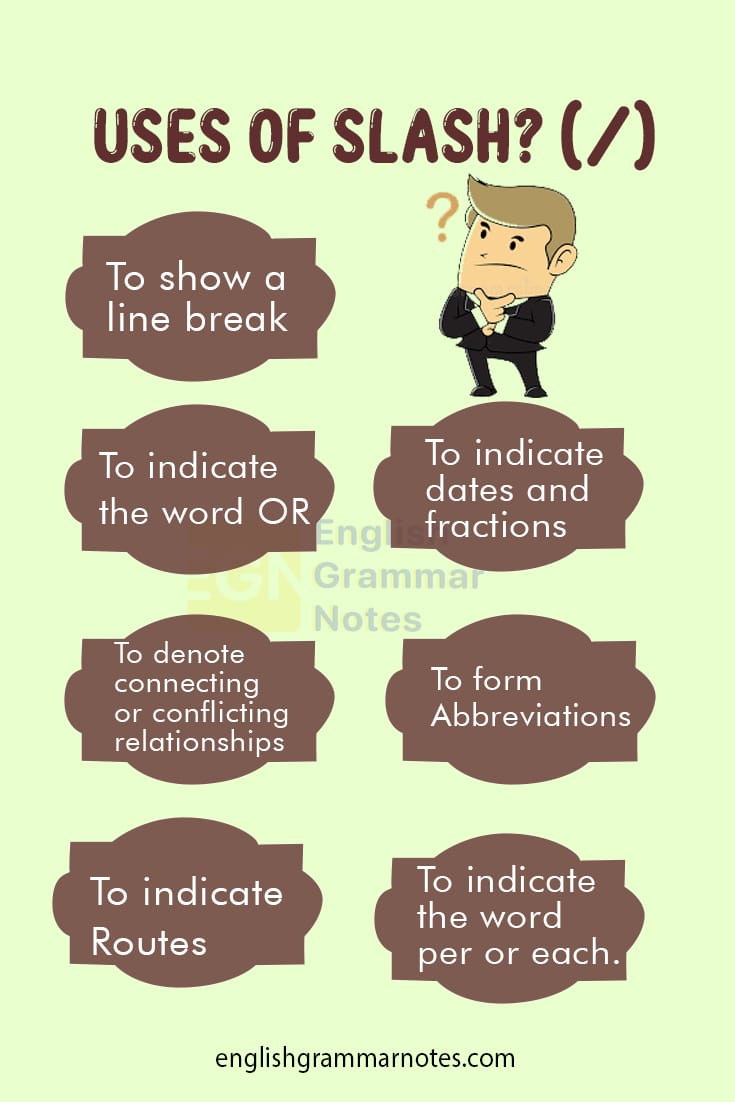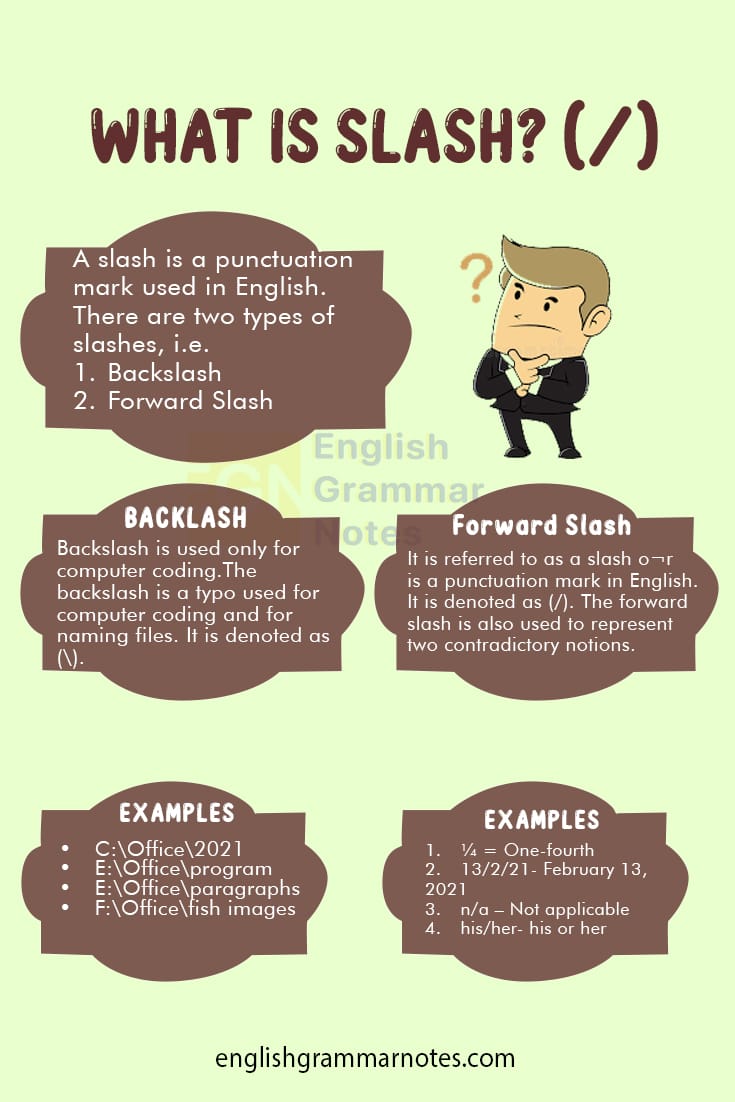Slash: A slash is a punctuation mark used in the English language.
There are two types of slashes, i.e.
- Backslash
- Forward Slash
Slash – A Punctuation Mark
- Backslash
- Forward Slash
- What does Forward Slash is used for?
- Uses of Slash
- History of Slash
- Some Things To Be Kept In Mind While Using A Slash
- Informal Use of Slash
Backslash
Backslash is used only for computer coding.
The backslash is a typo used for computer coding and for naming files. It is denoted as (\). It is mostly used in Windows systems to separate folder names in a computer. One can make a backslash on the computer by pressing the slash key above ENTER.
Examples of a backslash:
- C:\Office\2021
- E:\Office\program
- E:\Office\paragraphs
- F:\Office\fish images
Forward Slash
It is referred to as a slash or is a punctuation mark in English.
It is denoted as (/). The forward slash is also used to represent two contradictory notions.
Examples of a forward slash:
- ¼ = One-fourth
- 13/2/21- February 13, 2021
- n/a – Not applicable
- his/her- his or her
What does Forward Slash is used for?
What forward slash means in a sentence, paragraph, or essay depends on the context in which it is used.

Uses of Slash
To show a line break
A slash can be used to show a line break in a song or a poem, usually when several short lines are being written in conjunction. Add a space before and after the slash.
For example:
- Johnny Johnny Yes Papa,/ Eating sugar no papa,/ Telling a lie no papa,/ Open your mouth hahaha.
- Twinkle, twinkle, little star, / How I wonder what you are. / Up above the world so high, / Like a diamond in the sky.
To indicate the word OR
Usually, when a slash is used in a text, whether it is formal or informal, it indicates the word or. Only a forward slash is used to denote the word or. Do not use a space before or after the slash.
For example:
- Coffee/Tea for refreshment?
- We are going to the market/mall.
To indicate dates and fractions
The forward slash is mostly used to indicate dates and fractions. Use a slash to separate numerator and denominator in a fraction to attach a whole number and a fraction.
For example:
- 31/4/2020 – April 31, 2020
- 2/3- Two – third
- ½- One half
To denote connecting or conflicting relationships
It can denote either a connection or a conflict between phrases or words in a sentence.
For example:
- The manager prefers to work in his office room/at home.
- He is usually quiet/aggressive sometimes.
To form Abbreviations:
It can also form some shortened forms or abbreviations of words or phrases in a sentence.
For example:
- w/o = without
- a/c = air conditioning.
To indicate connecting and non-contrasting items
The punctuation mark slash is also used as a substitute for the word “and,” usually in situations where a hyphen or a dash is required.
For example:
- He is a European/Indian.
- He prefers Coffee/Tea both.
To indicate routes
The slash is also used to represent the stages of a route.
For example:
- Delhi/Chandigarh/Punjab as stops on tour.
Slashes are also used between words as in he/she, was/were. It indicates that either word is correct in the given context.
For example:
- His/her name is Rohan.
- They was/were playing in the ground.
To split up parts of a website address on the internet.
For example:
- https://www.-learn-english.com/eslpt-books.html
- https://myhealthbriefcase.com/best-wedge-pillow-after-surgery/
To indicate the word per or each.
For example:
- This pen costs $10/-
- 20 miles/hr – 20 miles per hour
- 70 lbs/day = 170 pounds a day or 170 pounds per day
It is also used to indicate something spanning two years.

History of Slash
Slashes may be used in early writing as a form of vertical strokes, dashes, etc. Presently slash is distinguished from other punctuation marks. It is derived from the medieval European Virgule, i.e., Latin word – Virgula, lit., which denotes a period, caesura mark or a scratch comma. Its use as a comma has become extensive in France, where it has also been used to mark the continuation of a word onto the next line of a page. In the early modern period of Central Europe, the Fraktur script was used to denote a single slash, i.e. (/) as a scratch comma and a double slash, i.e. (//) as a dash. Later on, the double slash was advanced into the double hyphen, i.e. (=).
This mark was generally known as the “oblique” in the English language during the eighteenth century. Oblique stroke was later shortened to stroke, which became the common British name of the punctuation mark. But still, general folk like printers and publishing professionals often used to refer to it as an “oblique”. It was also referred to as the shilling mark or solidus during the nineteenth and early twentieth century from its use as the currency sign for a shilling. The word “slash” was first attested in American English in the year 1961; therefore is considered to be a recent development. It has been used a lot in computing and has gained a wide currency.
Some Things To Be Kept In Mind While Using A Slash
It can be used to indicate an option, shorten two words and shorten one word, and display ambiguity.
For example:
- He has connected the i/o ports – i.e. Input/output
- I have a meeting with him/her tonight.
One should mostly try to avoid using slashes in regular texts as it disturbs the flow of the sentence and even distracts the reader; hence, one should try to avoid it, making it easier to read the sentences.
In a formal exam, the only acceptable use of a slash is to refer to two roles that one person plays, such as “producer/director” or “student/teacher.”
Informal Use of Slash
The Informal use of slash is as follows:
nonpartisan pronoun options: The last person to use the kitchen needs to clean up his/her messorShe/he who smelt it dealt it.
- Denoting qualities of a single entity usually referring to the word and: He’s an artist/student.
- signifying alternatives, usually referring to the word ‘or’: Cold drink/Coffee
- dates: 9/11or 2/9/2021
- Used in well-established phrases: ; n/a; c/o